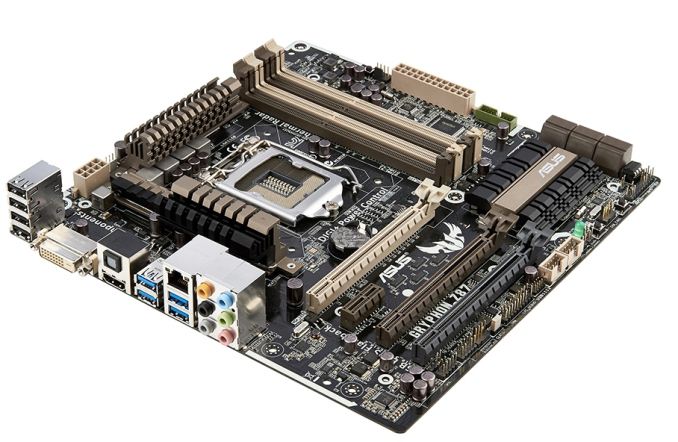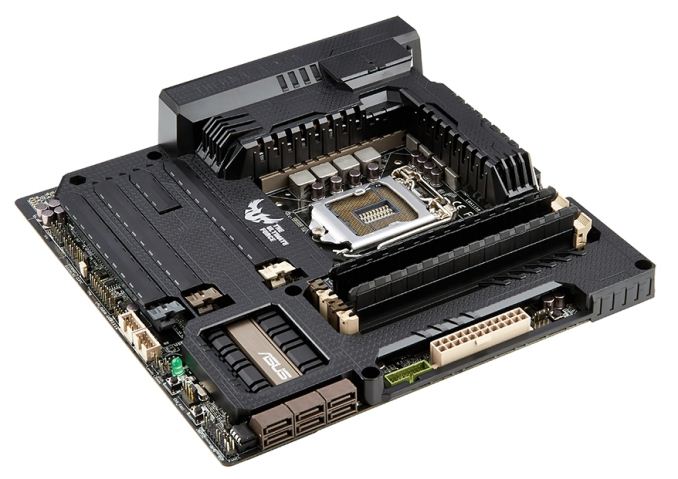ASUS TUF Z87 Gryphon Review
by Ian Cutress on February 3, 2014 10:00 AM EST- Posted in
- Motherboards
- Asus
- Z87
- TUF
ASUS TUF Z87 Gryphon Conclusion
When covering the Z87 Gryphon, or any TUF product, it is hard not to keep mentioning the warranty status. This is what the line is based on after all – a higher rated component, or ones in the higher end of the quality/yield spectrum, in order to provide that extra longevity. This is akin to Samsung making SSD NAND and keeping the best for themselves – the TUF range aim to source whatever components they put on the board from the higher echelons of production.
As a result, the special parts and warranty do come in the form of extra cost. You get what you pay for, right? The Gryphon has a rough time competing against other products in the same price segment for feature set. The Gryphon comes with no extra SATA Controllers, no extra USB 3.0 controllers or hubs, no power/reset buttons, no two digit LED, and so on. This all helps in keeping the component count down on a product (there is less to go wrong), but ultimately this also begs the question of whether a user needs more than six USB 3.0 ports, or more than six SATA 6 Gbps ports. Users can use PCIe cards if they needed more, some would suggest.
If we put the extended warranty and component choice out of our minds for a second, then the Gryphon has several features not on the regular channel market segment. First up is the number of temperature sensors on board. I counted 10, which includes three sensor headers for users to connect to other parts around the case (hard drives, PCIe cards). These tie into the fan control software which allows two point gradient configurations of all six 4-pin fan heads on board, and each fan profile can be tied into a weighted average of any of the sensors. For example, the CPU fans can rely on a profile where the temperature is calculated as 55% the CPU temperature, 35% the DRAM temperature and 10% the GPU temperature.
The Gryphon also offers an additional ‘Fan Overtime’ feature which keeps the fans spinning after the system is shut down in order to allow the equilibration of air inside and outside the case. This can be seen as important in humid climates, where hot air inside the case can cause inside condensation as it cools down. We have seen similar aspects on other motherboards, but this is the first time I have seen it on an ASUS product.
The Gryphon Armor Kit is sold separately to the motherboard and allows the board to be encased in a dust blocker that also forces cooling around the components on the motherboard. The rear plate also helps increase the rigidity of the motherboard due to large GPUs or awkward mounting locations.
While the Z87 Gryphon does not have overclocking as its primary focus, we achieved 4.6 GHz with our CPU sample, in line with many other Z87 motherboards we have tested before. Users looking for an automatic overclock will have to probe in the BIOS some to find them, but we get 4.1 GHz to 4.3 GHz within a few button presses easily. Performance is geared more towards longevity as well, so other motherboards might offer better stock performance too.
The Z87 Gryphon aims to sell on its main features: a five year warranty paired with the micro-ATX form factor. For that it does quite well, and ASUS are filling a well requested hole in their line-up. We have the Sabertooth in to review as well, which may satisfy the need for extra functionality, albeit in a larger size.












62 Comments
View All Comments
Sivar - Monday, February 3, 2014 - link
I was kind of hoping for an analysis of exactly how TUF motherboards differ from the rest. Technical details, specific component lists with a look at their manufacturer specifications, you know -- hardcore Anandtech stuff.Yes, it has a longer warranty, but is that because the "TUF" voltage regulators are rated for higher temperature environments (and similar), or is it more a marketing gimmick?
irusun - Monday, February 3, 2014 - link
Exactly! I actually strongly considered this board on my last build for a CAD workstation... Reliability and stability were primary factors. In the end, their marketing actually turned me off. The marketing seems to be more about appealing to G.I. Joe / Call of Duty fans with the over-the-top website, colors, and military lingo. I just wanted a "professional" geared board. I get the impression it might be a good board for less than ideal environmental conditions, still no idea if the board really would be any better in a typical office environment.HandsomeChow - Wednesday, February 12, 2014 - link
If you really want to see what components they are, just remove the top heatsink on the MOSFETS and there should be a product number on the Caps and the Mosfets and you can search them up along with the Inductors.jtd871 - Monday, February 3, 2014 - link
Bingo. Does the "armor" actually do anything worthwhile? Or is that just an expensive gimmick? I noticed also that the IO plate seems to have an open vent in it. => I think I see a potential path for dust entry into the armor! And how do you get enough cooling air to the heatsinks around the CPU if they're covered by the armor?! Downdraft cooler?khanov - Monday, February 3, 2014 - link
It's a great addition for people who frequently shoot at their pc's with bb guns. Also for those that open the side of the case and throw hard objects at the motherboard.Iketh - Saturday, February 8, 2014 - link
i lol'd...wish I could vote this upHandsomeChow - Wednesday, February 12, 2014 - link
In terms of Heat dissipation, the aim from Asus is to keep external heat sources from conducting to the motherboard. Hence the Armour being made out of plastic. But the internal components on the motherboard also admit some heat so it is a double edged sword. The Armour is more of a Dust protector/Moisture shield. And yes there are potential airflow gaps that will allow dust to enter but it is much less dust compared to a motherboard without the Armourkyuu - Monday, February 3, 2014 - link
Have to agree with this. We need more info on what exactly the differences are between this and a "run-of-the-mill" Z87 board. Did they use different components (higher quality capacitors, voltage regulators, etc.)? Did they undergo more validation? Does the armor kit do anything worthwhile, and does it hamper cooling in any way?FractinJex - Monday, February 3, 2014 - link
Here....I have used several for work related builds and one for myself they are awesome!TUF Black Metallic capacitors, chokes, and MOSFETs are screened by seven rigorous military-grade tests to ensure superior lifespan even under the most demanding conditions.
The components used are of about server grade quality in other words its a bit better than a standard board/mid range board 100-250$ range...most boards these days are built to last but most do not come with 5 year warranty either...and someone whos been in the industry most boards are built to last just that so go more some go less etc...
Currently atm this and the genie are the best matx boards available to date.
fokka - Monday, February 3, 2014 - link
"TUF Black Metallic capacitors, chokes, and MOSFETs are screened by seven rigorous military-grade tests to ensure superior lifespan even under the most demanding conditions." marketing speak much?